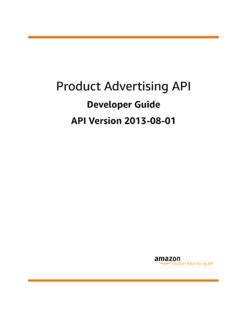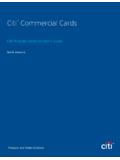Transcription of CHARLES M. APRIL 2013 - fmi-inc.net
1 FMI Financial Markets International, Inc. 818 Connecticut Avenue, NW Suite 300 Washington, DC 20006 Tel: (202) 721 0194 Fax: (202) 721 0198 I N D I A' S C O M M O D I T Y T R A N S A C T I O N TA X : EC O N O M I C C O N S EQ U E N C E S A N D I N T E R N AT I O N A L L ES S O N S L EA R N E D CHARLES M. SEEGER APRIL 2013 Abstract This paper assesses the recently proposed Indian Commodity Transaction Tax (CTT) and the foreseeable impact of this tax on the Indian economy. Prudential government regulation, particularly since 2003, has helped India to develop one of the most vibrant commodity sectors in the world. The sector employs millions, generates revenue, and propels growth. A wide range of economic actors in India rely on commodity exchanges for price discovery and to hedge exogenous risk. The proposed CTT fails to understand these economic objectives, and in doing so, is likely to deter commodity trading on Indian exchanges and shift transactions to lower cost exchanges overseas, or to illegal markets.
2 As trade volume decreases, so too will any revenues generated by the CTT. The CTT is further flawed as it disproportionately harms small and medium enterprises, would cause substantial job losses, and unfairly discriminates against certain economic sectors. This paper also provides empirical evidence of the harm of similar transaction taxes in other nations, which have reduced market liquidity and have failed to generate significant long-term revenue. Financial Markets International, Inc. (FMI) is an international law and economics consulting firm based in Washington, DC. FMI specializes in helping emerging market countries achieve economic growth and development through a reliance on market mechanisms, international best practices, and commercial law reform. Founded in 1992, FMI has worked around the globe for international donor agencies and private sector clients. FMI is well-known for its work in developing securities markets, commodity futures markets, capital markets, and non-bank financial institutions.
3 The firm's work encompasses capital markets development, pension reform, banking, SME access to finance, legislative drafting, institutional development, strategic planning, management information systems, and education and training initiatives. CHARLES M. Seeger, , is the President and CEO of FMI. He has provided legal, operational, and prudential advice on commodity risk management to governments, banks, and corporations worldwide. Mr. Seeger is a senior attorney specializing in capital markets development. He is the author of the USAID/New Delhi Roadmap: Commodity Futures Markets Development in India, 2005 and Forward. APRIL 2013 CHARLES M. Seeger Financial Markets International, Inc. 818 Connecticut Avenue, NW Suite 300. Washington, DC. (202) 721-0194. Introduction For over sixty years, the Government of India has pursued a measured and prudential path of commodity derivatives Laws and regulations adopted as part of India's economic liberalization in the 1990s and 2000s created a coherent and reliable legal regime, and sparked a dramatic modernization of India's commodity futures markets.
4 As a result, the total value of commodities traded on India's exchanges exceeded 181 trillion rupees ($ trillion) in the 2011-12 fiscal year, and this sector accounts for over million jobs. Yet, the Commodity Transaction Tax (CTT) proposed in the Ministry of Finance's 2013-2014 budget threatens to undermine this progress and cripple Indian commodity trading. The proposed CTT reflects a misunderstanding of the Indian commodity market and its important hedging and price discovery functions. It unfairly seeks to discriminate against certain economic actors and sectors, and would significantly harm individuals and small and medium enterprises (SMEs). Moreover, the tax ignores economic theory and the empirical experience of other failed transaction taxes imposed around the world. Further, the CTT is unlikely to generate significant tax revenues because the increased costs imposed by the tax will divert commodity trading away from India to overseas markets.
5 In sum, the CTT is a misconceived initiative with the potential to irreparably harm India's commodity futures markets. This memorandum outlines that harm, and the foreseeable problems of the new CTT. It provides a brief overview of India's commodity sector and its importance to the national economy; evaluates the proposed tax and details its adverse consequences for the commodity sector; and offers relevant context by recounting the experience of other nations that have implemented similar transaction taxes. Overview of the Indian Commodity Sector India's venerable open markets tradition can be traced to the 4th century BCE, when the esteemed scholar and statesmen Vi h ugupta, or Chanakya, wrote the Arthashastra. Writing more than two thousand years before Adam Smith, Vi h ugupta outlined many of the fundamental tenants of what would later be known as classical economics. He detailed the importance of commodity trade, market-based prices, mutually beneficial comparative advantage, and a fair tax system that generates revenue and promotes growth, without destroying economic 1.
6 See The Forwards Contracts (Regulation) Act of 1952, and subsequent revisions. 2. Kautilya, Arthashastra, Translated by R. Shamasastry, Bangalore: Government Press, 1915. 1. The legacy of the Arthashastra was apparent in the late 19th century, when merchants, producers, and traders in India first formalized the use of commodity derivatives for risk management and hedging purposes. In 1875, the Bombay Cotton Trade Association organized a futures market, and that system spread to other commodities in major cities across India. At the outbreak of World War II such trading ceased, but commenced again in 1952 under the auspices of the Forward Markets Commission and the Forwards Contracts (Regulation) Act. During that early period, governmental regulation was erratic and inconsistent, and the government eventually suspended trading in 1966 due to fear of price manipulation on unregulated exchanges. In 1980, following the Indian Commodity Market Studies recommendations of the seminal report of India's commodity market development reflects the Khurso Committee, the government government of India's sustained commitment to reintroduced limited futures trading for gradual reform consistent with international several committees, including cotton, economic theory, experience, and best practices.
7 A. kapas, jute, and potatoes. India's embrace number of domestic and international studies informed this process, including: of economic openness in the early 1990s, including accession to General Agreement Khurso Committee Report (1980). on Tariffs and Trade (GATT) and the Kabra Committee Report (1994). World Trade Organization (WTO), led to the prudential development of modern World Bank & UNCTAD: Managing Price Risks commodity trading in the country. In 1993, with Futures Markets (1996). the government appointed Kabra World Bank: Brokerage (2000). Committee recommended the revival of previously banned commodity futures, as World Bank: Clearing House (2000). well as the introduction of new World Bank: Improving Commodities Futures commodities such as silver. The World Markets (2000). Bank and United Nations Conference on Trade and Development (UNCTAD) World Bank: Warehouse Receipt Systems (2000). reports highlighted the benefits of futures Guru Committee Report (2001).
8 Trading as a risk management tool. A series of other domestic and international studies The Report of the Group on Forward and Futures Markets (2001). followed (see textbox), which collectively led to the development of a transparent, The Ramamoorthy Committee Report (2003). fair, and methodological legal and regulatory regime for commodity futures The Report of the Inter-Ministerial Task Force on Convergence of Securities and Commodity trading in India. Derivatives Markets (2003). Modern commodity trading USAID Roadmap: Commodity Futures Market Development in India 2005 and Forward (2004). commenced in India in 2003 with the establishment of three national exchanges 2. that met stringent government criteria. In just one decade, India now boasts one of the most vibrant commodity derivatives sectors in the world. The total value of commodities traded on India's exchanges exceeded 181 trillion rupees ($ trillion) in the last fiscal year, constituting a 65% increase from the previous Metal and energy derivatives account for 88% of trading value, with agricultural commodities totaling 12%.
9 Market participants include corporate users of agricultural products, metals, and energy, as well as small and medium size businesses that rely on exchanges for hedging and price discovery. India's largest commodity exchange, the Multi-Commodity Exchange (MCX), was a mere idea ten years ago, yet is now the third largest commodity futures exchange in the world based on total number of trades. MCX grew in trading volume by 12% in 2012, despite the global exchange traded derivatives market contracting by 15%.4 India's commodity sector has generated over million jobs, and impacts the lives of millions India has become a global leader in commodity trading, and the development of these markets has created jobs and propels economic growth. The Proposed CTT and its Faults The 2013-14 Union Budget, presented by Finance Minister P. Chidambaram, proposed a tax of .01% to be levied on the sale of all non-agricultural commodity derivatives.
10 According to Mr. Chidambaram, the CTT is based on the premise that there is no distinction between derivative trading in the securities market and derivative trading in the commodities market. 6 This tax, and its asserted rationale, is flawed for five economic reasons; it is also flawed for the lessons learned from the adverse consequences suffered by other nations that have imposed such a tax. Securities Investment versus Commodities Hedging. The asserted premise underlying the CTT that there is no distinction between securities and commodity derivatives' trading fails to account for the economic functions of commodity derivatives. Securities are instruments for entrepreneurs and businesses to raise capital, and for investors to profit from the rise and fall of prices. Commodity futures' key economic function is to hedge against price risks based on the underlying physical commodity. Hedging activity reduces unforeseen, but previously existing, economic loss created by price fluctuations, and such does not yield positive profits akin to securities trading.






